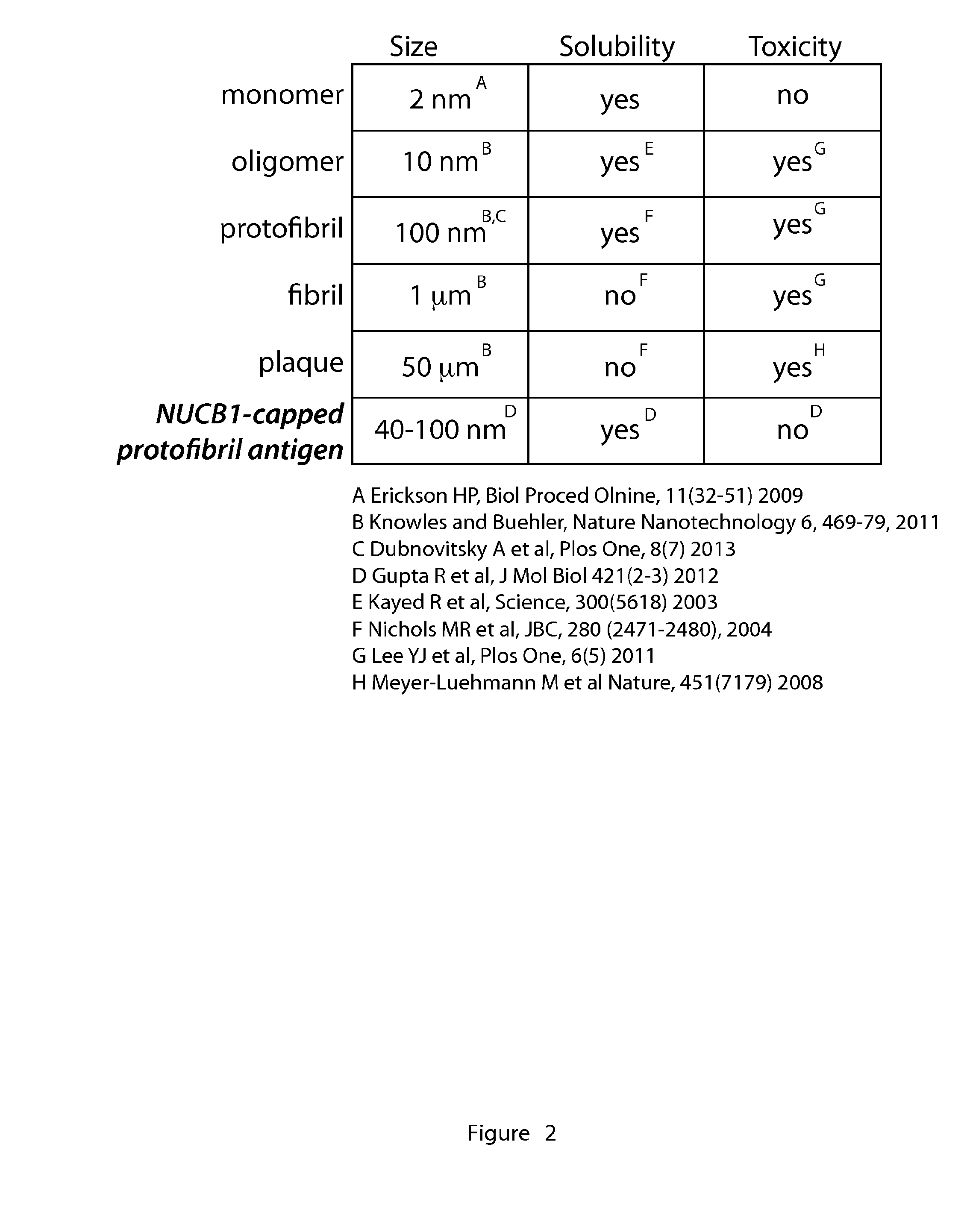Amyloid Protofibril Antibodies and Methods of Use Thereof
a technology of antibodies and myloids, applied in the field of antibodies for myloids and their protofibrils, can solve the problems of underlying problems, -cell death and loss of natural insulin production, and inability to cure the underlying cause of reduced insulin secretion,
- Summary
- Abstract
- Description
- Claims
- Application Information
AI Technical Summary
Benefits of technology
Problems solved by technology
Method used
Image
Examples
example 1
Stabilization of Amyloid Protofibrils by NUCB1
[0123]Despite that observation that amyloid oligomers and protofibrils are believed to be the key culprits in amyloid-induced cell toxicity, the isolation and stabilization of these intermediates along the pathway of fibril formation has been a challenge. We have determined that NUCB1 offers a novel strategy to stabilize protofibrillar species of hIAPP (FIG. 3) (10). Using size-exclusion chromatography (SEC) on a fast performance liquid chromatography (FPLC) instrument, we were able to isolate a mixture of NUCB1-capped hIAPP protofibrils, which we characterized using a number of biophysical and imaging methods (FIG. 3) (10). NUCB1 and hIAPP were incubated together and then subjected to SEC. The SEC chromatogram shows two peaks, one at 7.6 ml (Peak 1) and another at 11.8 ml (Peak 2). Injection of a solution of NUCB1 alone onto the column generates a peak centered at 11.8 ml. Since hIAPP contains only one Tyr and no Trp residues, NUCB1 dom...
example 2
Immunization of Mice with NUCB1-Capped hIAPP Protofibrils and Recovery of scsAb
[0126]To develop stabilized conformation-specific (scsAb) mAbs, purified NUCB1-capped hIAPP protofibrils from peak 1 were isolated with SEC and used as antigen in an immunization and myeloma fusion protocol (FIG. 4). These NUCB1-capped hIAPP protofibrils are stable for weeks and thus represent a novel antigen for conformation-specific mAb development. We used in-house low throughput dot-blot immunoreactivity screen to find clones that generically react with a collection of protofibril or fibril species. As hypothesized, it appears that several of the mAbs react with hIAPP, while others react with fibrils that originate from other amyloidogenic peptides, including Aβ42 and an artificial aggregating protein named β23. Aβ42 is the peptide that constitutes the amyloid plaques characteristic of Alzheimer's disease. We have so far identified eleven mAb-producing myeloma clones. The mAbs from 4 clones (4a8.e11, ...
example 3
Staining of Human Brain Sections with scsAb
[0127]The scsAb mAb 5a8.b11, which exhibits preferential binding to Aβ42 protofibrils (FIG. 5), was used to stain human brain samples from subjects with familial Alzheimer's disease. Controls include tissue from normal subjects, a commercial antibody that reacts with anti-Aβ42 fibrils, a no antibody control, and another scsAb (mAb 3b10.e9) that reacts with hIAPP protofibrils but not with Aβ42 protofibrils (FIG. 5).
[0128]The staining results obtained with scsAb mAb 5a8.b11 can be distinguished from the control anti-Aβ42 antibody was a gift from Jan Näslund by way of Annica Rönnbäck at the Karolinska Institute, Sweden. This difference in the staining patterns because the new mAb is presumed to stain protofibrils and not fibrils. The scsAb mAb 5a8.b11 exhibits an intracellular staining pattern is very specific and does not stain the extracellular materials like the commercial anti-Aβ42 fibril antibody.
PUM
| Property | Measurement | Unit |
|---|---|---|
| Concentration | aaaaa | aaaaa |
Abstract
Description
Claims
Application Information
 Login to View More
Login to View More - R&D
- Intellectual Property
- Life Sciences
- Materials
- Tech Scout
- Unparalleled Data Quality
- Higher Quality Content
- 60% Fewer Hallucinations
Browse by: Latest US Patents, China's latest patents, Technical Efficacy Thesaurus, Application Domain, Technology Topic, Popular Technical Reports.
© 2025 PatSnap. All rights reserved.Legal|Privacy policy|Modern Slavery Act Transparency Statement|Sitemap|About US| Contact US: help@patsnap.com



